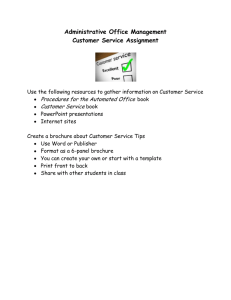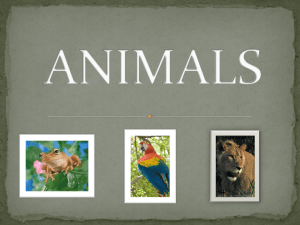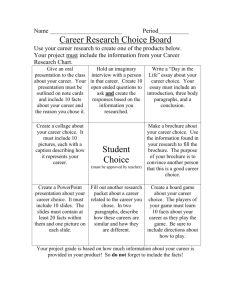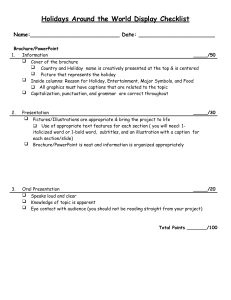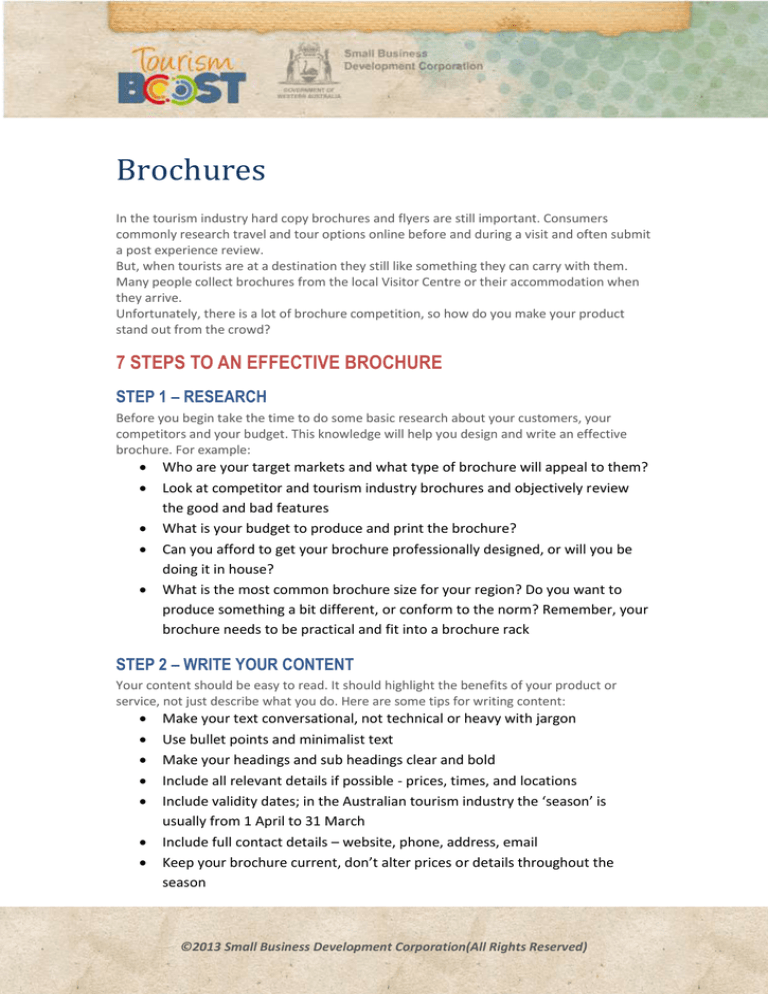
Brochures
In the tourism industry hard copy brochures and flyers are still important. Consumers
commonly research travel and tour options online before and during a visit and often submit
a post experience review.
But, when tourists are at a destination they still like something they can carry with them.
Many people collect brochures from the local Visitor Centre or their accommodation when
they arrive.
Unfortunately, there is a lot of brochure competition, so how do you make your product
stand out from the crowd?
7 STEPS TO AN EFFECTIVE BROCHURE
STEP 1 – RESEARCH
Before you begin take the time to do some basic research about your customers, your
competitors and your budget. This knowledge will help you design and write an effective
brochure. For example:
Who are your target markets and what type of brochure will appeal to them?
Look at competitor and tourism industry brochures and objectively review
the good and bad features
What is your budget to produce and print the brochure?
Can you afford to get your brochure professionally designed, or will you be
doing it in house?
What is the most common brochure size for your region? Do you want to
produce something a bit different, or conform to the norm? Remember, your
brochure needs to be practical and fit into a brochure rack
STEP 2 – WRITE YOUR CONTENT
Your content should be easy to read. It should highlight the benefits of your product or
service, not just describe what you do. Here are some tips for writing content:
Make your text conversational, not technical or heavy with jargon
Use bullet points and minimalist text
Make your headings and sub headings clear and bold
Include all relevant details if possible - prices, times, and locations
Include validity dates; in the Australian tourism industry the ‘season’ is
usually from 1 April to 31 March
Include full contact details – website, phone, address, email
Keep your brochure current, don’t alter prices or details throughout the
season
©2013 Small Business Development Corporation(All Rights Reserved)
STEP 3 – WRITE YOUR HEADING
The biggest mistake people make is putting their logo or business name at the top of a
brochure. In a brochure rack only the top third of your brochure will be visible, this is
valuable real estate, don’t waste it with text no one but you will appreciate. Visitors don’t
care which company is responsible for giving them an amazing experience, they just want to
experience it!
Write something eye catching that attracts your target market in the top third of your
brochure.
STEP 4 – CHOOSE IMAGES AND GRAPHICS
It is very important to choose images that showcase the unique selling point of your product
or service and suit your target market. The images need to inspire people to want to jump in
and experience what you are offering.
Here are some things to consider:
Use high quality images - have some professionally taken if necessary
Showcase your business with images of people actually experiencing what
you offer
One excellent, large photo is often better than lots of small images; this is
called a ‘hero shot’
If you are using a map or other graphics make sure they are simple and clear
Tourism WA has an online image library that can be used to obtain photographs for your
marketing promotions.
STEP 5 – DESIGN YOUR COVER
The cover is obviously the most important part of your brochure as it is the first thing people
see and it should inspire them to choose your brochure over others. At first glance your
cover should:
Obviously depict what your product is about
Clearly show who your product is aimed at
Describe the main benefit your product will give to the visitor
Evoke a ‘must do’ response
STEP 6 – DECIDE ON THE TECHNICAL ELEMENTS
Choose which fonts you want to use. It is best to select common, neat fonts,
such as Verdana or Tahoma
Don’t mix and match your fonts, too many fonts will make your brochure look
messy and crowded
What size do you want your brochure to be? The most common sizes are DL
and A4. When choosing your size, take into consideration how it will be
distributed and how it will fit into brochure racks
©2013 Small Business Development Corporation(All Rights Reserved)
What weight, colour, and texture paper do you want to use? Basic white
paper will give you a clean slate so that your images and text stand out more.
A thicker paper will ensure your brochure stands up in racks and looks
professional
STEP 7 – DISTRIBUTION
The next step is deciding where to display your brochure. The aim is to have your brochure
displayed in as many appropriate places as possible.
You can pay a brochure distribution company to store and distribute your brochures for you,
or you can get them into the marketplace yourself. The easiest way to DIY is to invest in
some DL or A4 brochure stands and then try your luck in the following suggested outlets:
Your local visitor centre
Other tourism and local businesses
Accommodation outlets
Outside your own business premises
Attached to your vehicle
The local shopping centre
You might also want to consider distributing your brochure at consumer and trade shows.
The easiest and cheapest way to do this is through your Regional Tourism Organisation
(RTO) – visit www.tourism.wa.gov.au to get the contact details of your RTO.
SOME FINAL BROCHURE DESIGN TIPS...
White space is good! Do not over clutter your brochure
Avoid printing on folded lines
Don’t print text over an image as it is VERY hard to read
Don’t use too many different colours with your text, it detracts from the main
message you are trying to get across
It is worth getting a professional print job. It is probably cheaper to go
through a printing company, and it will look a whole lot better than doing it
yourself
SEEKING PROFESSIONAL HELP
If your budget allows, you may decide to use professionals to help you produce the perfect
brochure. Obtain at least three quotes for professional services and ask to see previous work
to ensure you are getting the quality you desire.
©2013 Small Business Development Corporation(All Rights Reserved)

